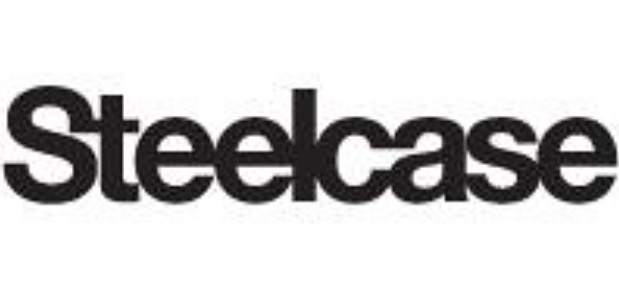Steelcase Logo: Meaning, History, Design Influences, and Evolution

Contents
In the world of design, there are logos that captivate and inspire, leaving a lasting impression on our minds. One such logo is that of Steelcase, a renowned furniture company known for its innovative products and exceptional quality. The Steelcase logo is not just a symbol, but a carefully crafted representation of the company’s values, heritage, and vision. In this article, we delve into the meaning behind the logo, trace its intriguing history, explore the design influences that shaped it, and discuss its evolution over the years.
Understanding the Steelcase Logo
Before we uncover the deeper meaning of the Steelcase logo, it is important to take a closer look at its design. The logo features a clean and modern typographic treatment, with the company name crafted in bold, uppercase letters. The choice of font exudes strength and stability, reflecting the core values of Steelcase. The letters align perfectly, creating a sense of harmony and balance.
Beneath the company name, a simple, elegant symbol takes center stage. This symbol comprises four interconnected circular shapes. Each circle represents an essential aspect of Steelcase’s philosophy: collaboration, innovation, sustainability, and quality. The interconnectivity of these circles symbolizes the integration of these values within the company’s products and services.
The Meaning Behind the Design
At its core, the Steelcase logo is a symbol of unity and synergy. The interconnected circles represent the seamless collaboration between different departments and teams within Steelcase. It highlights the company’s commitment to teamwork, encouraging employees to work together towards a common goal.
Furthermore, the circles in the logo also represent the synergy between Steelcase and its clients, emphasizing the company’s dedication to understanding and meeting their needs. The logo serves as a visual reminder to create spaces that foster connection and promote productivity.
The Symbolism in the Steelcase Logo
Beyond its visual appeal and underlying meaning, the Steelcase logo carries symbolic significance as well. The circles in the symbol signify continuous movement and growth, representing Steelcase’s commitment to innovation and adaptation in an ever-evolving industry.
Moreover, the circular shape symbolizes unity and equality, reinforcing Steelcase’s belief in the power of diverse perspectives and inclusive work environments. It serves as a reminder to embrace collaboration and leverage the strength of collective ideas.
Additionally, the choice of color in the logo holds significance. The deep blue hue represents trust, reliability, and professionalism. It conveys a sense of dependability and instills confidence in Steelcase’s clients and partners.
Furthermore, the white space surrounding the logo symbolizes openness and clarity. It represents Steelcase’s commitment to transparency and honesty in its business practices. The absence of clutter in the design reflects the company’s focus on simplicity and efficiency.
Tracing the History of the Steelcase Logo
Now that we have explored the intricacies of the Steelcase logo, let us take a step back in time to understand its evolutionary journey. The logo has undergone several transformations throughout the company’s history, evolving alongside changes in design trends and brand identity.
The Original Logo and its Significance
When Steelcase was founded in 1912, its logo reflected the prevailing design sensibilities of the time. The original logo featured an intricate, ornamental crest with the company name enclosed within a shield. This design was a reflection of the era’s emphasis on craftsmanship and attention to detail.
Symbolically, the shield in the original logo represented strength and protection, conveying the idea that Steelcase was a reliable and trustworthy brand. It was a visual representation of the company’s commitment to quality and durability, qualities that have remained consistent throughout its history.
Key Changes Over the Years
As times changed and design trends evolved, Steelcase recognized the need to modernize its brand identity. In the 1960s, the logo underwent a significant transformation, moving away from the ornate crest and embracing a simpler, more contemporary design.
The new logo featured a sleek, uppercase rendering of the company name, with the iconic interlocking circles positioned beneath it. This redesign marked a departure from the traditional and signaled a shift towards a more innovative and forward-thinking approach. It was a visual representation of Steelcase’s commitment to adapt to the changing needs of its clients and the evolving design landscape.
Fast forward to the 1990s, a decade marked by rapid technological advancements and a growing focus on sustainability. Steelcase once again recognized the importance of staying relevant and decided to give its logo a subtle yet impactful update.
The new logo retained the sleek typography and interlocking circles but introduced a fresh color palette. The addition of vibrant shades symbolized the company’s embrace of a more environmentally conscious approach, reflecting its commitment to sustainable practices and materials.
Furthermore, the interlocking circles in the logo took on a deeper meaning. They represented the interconnectedness of Steelcase’s diverse range of products and services, highlighting the company’s holistic approach to creating innovative workspaces that foster collaboration and productivity.
Design Influences on the Steelcase Logo
The creation of any logo is influenced by a myriad of factors, ranging from architectural styles to artistic movements. The Steelcase logo is no exception, drawing inspiration from various sources that have shaped design history.

Architectural Inspirations
One notable influence on the Steelcase logo is modernist architecture. The clean lines and geometric shapes found in prominent architectural works of the mid-20th century inspired the minimalistic design approach seen in the logo. The logo’s simplicity echoes the architectural principles of form following function and emphasizes the timeless elegance that modernist architecture embodies.
Additionally, the interconnecting circles in the logo draw inspiration from architectural elements such as arches, creating a sense of strength and structural integrity.
Cultural and Artistic Influences
Artistic and cultural movements also played a role in shaping the Steelcase logo. The logo’s clean typography and minimalistic design reflect the influence of the Bauhaus movement, which championed simplicity, functionality, and harmony. This design philosophy resonated with Steelcase’s commitment to creating products that seamlessly blend style and functionality.
Moreover, the use of circles in the logo can be traced back to the symbolism of unity and wholeness found in various cultural contexts. This symbolism transcends borders and time periods, resonating with people across different cultures and backgrounds.
The Evolution of the Steelcase Logo
As design trends continue to evolve, it is natural for logos to undergo transformations reflecting the changing times. The Steelcase logo has seen its fair share of evolution, adapting to the shifting design landscape while staying true to its core principles.

The Shift in Design Philosophy
In recent years, the Steelcase logo has embraced a more streamlined and contemporary aesthetic. The typography has been refined, with subtle modifications made to improve legibility and evoke a sense of modernity.
Furthermore, the interconnecting circles in the logo have been given a sleeker and more dynamic appearance, reflecting the company’s embrace of technological advancements and innovative design solutions.
Modern Interpretations and Future Directions
As we look to the future, it is exciting to envision the potential directions the Steelcase logo might take. The logo will undoubtedly continue to reflect the company’s commitment to collaboration, innovation, sustainability, and quality.
With the rapid advancements in technology and the ever-changing design landscape, the logo may evolve to incorporate interactive elements or make use of emerging design techniques. However, one thing remains certain: the Steelcase logo will always stand as a symbol of the company’s unwavering dedication to creating inspiring and transformative workspaces.
In conclusion, the Steelcase logo represents more than just a visual identity. It is a reflection of the company’s values, a testament to its heritage, and a symbol of its commitment to design excellence. As we continue to encounter this iconic logo in our everyday lives, let us remember the meaning, history, design influences, and evolution that have shaped it into what it is today.
Inspired by the rich history and evolution of the Steelcase logo? Now it’s your turn to create a logo that embodies your brand’s values and vision. With Boon, you can harness the power of Artificial Intelligence to design a custom logo that resonates with your audience. Whether you’re looking to engage users, tell a compelling story, or strengthen your business, Boon makes it simple. Ready to see what you can create in just five minutes? Let’s make a logo!

Mia Vargas is our Senior SEO & Branding Specialist, a dynamic force in digital strategy with a keen eye for brand storytelling. With over a decade of experience in optimizing online visibility and shaping brand identities, Mia seamlessly combines her technical SEO expertise with her passion for creativity. She is skilled at crafting strategies that not only elevate search rankings but also resonate with target audiences, ensuring our clients build meaningful, lasting connections. Known for her innovative approach and trend-focused insights, Mia plays a crucial role in driving our team to stay ahead in a rapidly changing digital landscape, balancing analytics with artistic flair to deliver impactful results.
